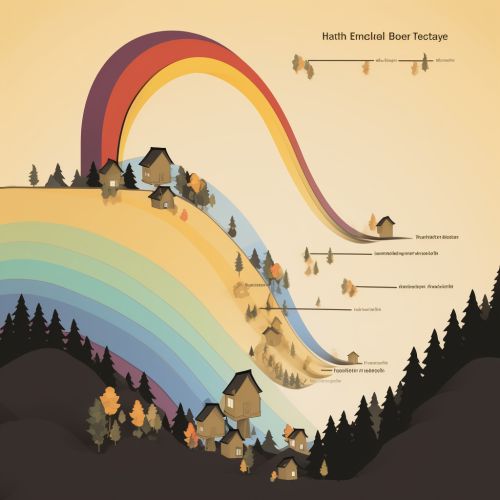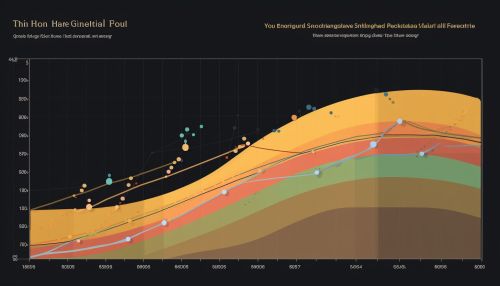Demographic transition
Introduction
The demographic transition is a model that describes population changes over time. It is a theory that was initially formulated by the American demographer Warren Thompson in 1929, and has since been expanded upon by numerous other demographers. The model is based on the observation of demographic changes that occurred in Western Europe between the end of the 18th century and the beginning of the 20th. It posits that societies progress from a pre-industrial state of high birth and death rates to a post-industrial state of low birth and death rates, a transition driven by technological advancements and socio-economic changes.


Stages of Demographic Transition
The demographic transition model is typically divided into four or five stages, each characterized by specific birth and death rates, and hence, rates of population growth.
Stage One: Pre-Industrial Society
In the first stage of the demographic transition, both birth and death rates are high, which results in a relatively stable population size. This stage is typically associated with pre-industrial societies, where subsistence agriculture is the predominant economic activity. High birth rates are often due to cultural norms, economic necessity, and a lack of family planning. High death rates, on the other hand, are typically due to disease, famine, and lack of access to healthcare and sanitation.
Stage Two: Urbanization and Industrialization
The second stage of the demographic transition is characterized by a rapid decline in death rates followed by a slower decline in birth rates. This stage is often associated with urbanization and industrialization, which bring about improvements in sanitation, healthcare, and food production. The decline in death rates leads to a period of rapid population growth, while birth rates remain high.
Stage Three: Mature Industrial Society
In the third stage of the demographic transition, birth rates begin to decline, while death rates continue to stay low. This stage is typically associated with mature industrial societies, where there is increased access to contraception, a shift from agricultural to industrial economies, and changing social norms that favor smaller families. The rate of population growth slows during this stage.
Stage Four: Post-Industrial Society
The fourth stage of the demographic transition is characterized by both low birth and low death rates. This stage is associated with post-industrial societies, where there is a high degree of urbanization, a dominant service sector, and high levels of education and income. The population size stabilizes or even begins to decline in this stage.
Some demographers propose a fifth stage of the demographic transition, where birth rates fall below death rates, leading to a decline in population size. However, this stage is not universally accepted and is still a topic of ongoing research and debate.
Factors Influencing Demographic Transition
Several factors influence the demographic transition, including economic development, education, healthcare, and cultural norms.
Economic Development
Economic development plays a crucial role in the demographic transition. Improvements in healthcare, sanitation, and food production, which are often associated with economic development, can lead to a decline in death rates. Similarly, a shift from agricultural to industrial or service-based economies can lead to a decline in birth rates, as children are less economically beneficial in these types of economies.
Education
Education, particularly of women, is another important factor in the demographic transition. Higher levels of education are associated with lower birth rates, as educated women often choose to delay childbirth in favor of pursuing careers. Additionally, education increases awareness of family planning methods, leading to lower birth rates.
Healthcare
Improvements in healthcare, including access to contraception and maternal care, can lead to a decline in both birth and death rates. Improved healthcare can reduce infant and child mortality, which can in turn lead to a decline in birth rates, as parents do not need to have as many children to ensure some survive to adulthood.
Cultural Norms
Cultural norms and societal values can also influence birth and death rates. For example, in societies where large families are valued, birth rates may remain high even as death rates decline. Conversely, in societies where small families are the norm, birth rates may decline more rapidly.
Criticisms and Limitations of the Demographic Transition Model
While the demographic transition model provides a useful framework for understanding population changes over time, it has been criticized for its simplicity and its assumption of a universal pattern of demographic change. Some of the main criticisms and limitations of the model include:
Assumption of a Universal Pattern
The demographic transition model assumes that all societies will pass through the same sequence of stages in the same order. However, this is not necessarily the case. For example, some developing countries have experienced a decline in birth rates before a significant decline in death rates.
Lack of Attention to Migration
The demographic transition model focuses on birth and death rates, but it does not take into account migration, which can significantly affect population size and composition.
Oversimplification of Complex Processes
The demographic transition model simplifies complex demographic processes into a series of stages. This can make it difficult to capture the nuances and complexities of demographic change.
Conclusion
Despite its limitations, the demographic transition model remains a valuable tool for understanding the broad patterns of demographic change over time. It provides a framework for analyzing population trends and for predicting future changes in population size and composition. However, it should be used with caution, and supplemented with other models and theories, to fully understand the complexities of demographic change.
See Also
References
- Thompson, W. (1929). Population. American Journal of Sociology, 34(6), 959-975.
- Notestein, F. (1945). Population - The Long View. In T. Schultz (Ed.), Food for the World. Chicago: University of Chicago Press.
